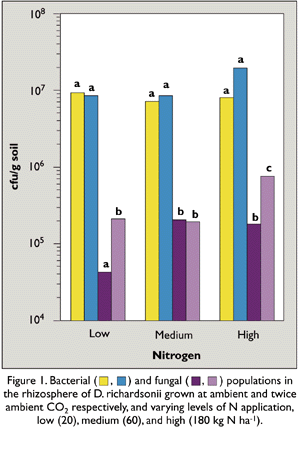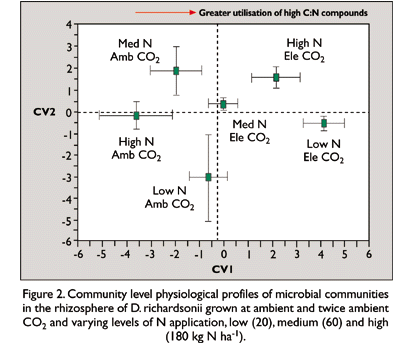 This page has been mothballed.
This page has been mothballed.
It is no longer being updated but we've left it here for reference.
Imapct of Elevated CO2 on Soil Microbial Ecology
- Collaborators
- CSIRO, Division of Plant Industry, Canberra, Australia
The concentration of atmospheric CO2 has risen from 280 to 362 ppm in the last nine decades and is predicted to continue to rise by on average 1.5 ppm per year. Commonly, plants respond to elevated CO2 by fixing more carbon, leading to increased plant biomass and below ground carbon allocation. Quantitative and qualitative changes in carbon entering the soil as litter or rhizodeposition, under elevated CO2 will have important consequences for nutrient cycling and acquisition, through effects on both the composition and size of the soil microbial community. In particular the C:N ratio of plant litter influences the decomposition rate. Roger Gifford and Jason Lutze, in earlier studies at CSIRO in Canberra, showed that under elevated CO2 the C:N ratio of plant litter and exudates increase. It has been hypothesized that this increase in C:N ratio will slow the rate of litter decomposition, reducing N mineralisation and N availability to the plant. However, despite the recognised importance of the soil microbial community in nutrient cycling and storage, relatively little is known about the effects of elevated CO2 on rhizodeposition or the consequences for the rhizosphere microbial composition and activity.
Through international collaboration with CSIRO in Canberra we
were able to address these questions, bringing together their expertise in
plant physiological responses to elevated CO2 and our expertise on microbial
community assessment. The phytotron growth facilities at CSIRO, dedicated to
elevated CO2 studies, were used to grow swards of Danthonia richardsonii (a
native C3 Australian grass) at ambient and twice ambient CO2 and varying levels
of low N application (20, 60, 180 kg N ha-1). We were able to show that the C:N
ratio of shoots, plant litter, roots and
 soil increased in plants grown at
elevated CO2 and there was an increase in total soil carbon at elevated CO2
across all N treatments. We used the Biolog system to construct community level
physiological profiles (CLPP) of the microorganisms from the rhizosphere of D.
richardsonii. We used Biolog GN and MT plates, the latter to which more
ecologically relevant root exudate C sources were added, to characterise the
communities.
soil increased in plants grown at
elevated CO2 and there was an increase in total soil carbon at elevated CO2
across all N treatments. We used the Biolog system to construct community level
physiological profiles (CLPP) of the microorganisms from the rhizosphere of D.
richardsonii. We used Biolog GN and MT plates, the latter to which more
ecologically relevant root exudate C sources were added, to characterise the
communities.
We showed that microbial community structure, in the
rhizosphere of D. richardsonii, changes when the plants are grown at elevated
CO2, with a preferential stimulation of fungal growth (Figure 1). This is the
first study to demonstrate such a change. These changes were due to the grass
exuding compounds with a higher C:N ratio when grown at elevated CO2. This was
reflected in a significantly greater utilisation of all C sources, except those
with a low C:N ratio (neutral and acidic amino acids, amides, N-heterocycles,
long chain aliphatics) by microbial communities from the rhizosphere of
elevated CO2
 grown
plants (Figure 2). The preferential stimulation of fungi under elevated CO2
could be due to an increase in quantity, but decrease in quality of litter,
because fungi grow on more complex substrates and they are more efficient at
converting substrate into biomass than bacteria. This preferential fungal
growth also explains the apparently conflicting findings of previous studies of
the effects of elevated CO2 on soil microorganisms, some of which showed
increases in microbial biomass and activity and some showing no effect on
bacterial numbers.
grown
plants (Figure 2). The preferential stimulation of fungi under elevated CO2
could be due to an increase in quantity, but decrease in quality of litter,
because fungi grow on more complex substrates and they are more efficient at
converting substrate into biomass than bacteria. This preferential fungal
growth also explains the apparently conflicting findings of previous studies of
the effects of elevated CO2 on soil microorganisms, some of which showed
increases in microbial biomass and activity and some showing no effect on
bacterial numbers.
These results have important implications for understanding carbon turnover and storage in soils. Under elevated CO2 changes in soil microbial community structure and stimulation of the activity of microorganisms which prefer to grow on rhizodeposits may lead to a decrease in the decomposition of organic matter and result in an accumulation of soil carbon.

